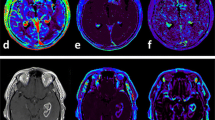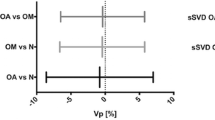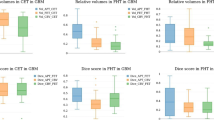Abstract
Objectives
To compare dynamic contrast-enhanced MRI (DCE-MRI) data obtained using different prebolus T1 values in glioma grading and molecular profiling.
Methods
We retrospectively reviewed 83 cases of gliomas: 46 lower-grade gliomas (LGG; grades II and III) and 37 high-grade gliomas (HGG; grade IV). DCE-MRI maps of plasma volume fraction (Vp), extravascular-extracellular volume fraction (Ve), and tracer transfer constant from plasma to tissue (Ktrans) were obtained using a fixed T1 value of 1400 ms and a measured T1 obtained with variable flip angle (VFA). Tumour segmentations were performed and first-order histogram parameters were extracted from volumes of interest (VOIs) after co-registration with the perfusion maps. The two methods were compared using Wilcoxon matched-pairs signed-rank test and Bland-Altman analysis. Diagnostic accuracy was obtained and compared using ROC curve analysis and DeLong’s test.
Results
Perfusion parameters obtained with the fixed T1 value were significantly higher than those obtained with the VFA. As regards diagnostic accuracy, there were no significant differences between the two methods both for glioma grading and molecular classification, except for few parameters of both methods.
Conclusions
DCE-MRI data obtained with different prebolus T1 are not comparable and the definition of a prebolus T1 by T1 mapping is not mandatory since it does not improve the diagnostic accuracy of DCE-MRI.
Key Points
• DCE-MRI data obtained with different prebolus T1 are significantly different, thus not comparable.
• The definition of a prebolus T1 by T1 mapping is not mandatory since it does not improve the diagnostic accuracy of DCE-MRI for glioma grading.
• The use of a fixed T1 value represents a valid alternative to T1 mapping for DCE-MRI analysis.






Similar content being viewed by others
Abbreviations
- HGG:
-
High-grade gliomas
- IDH:
-
Isocitrate dehydrogenase
- K trans :
-
Tracer transfer constant from plasma to tissue
- LGG:
-
Lower-grade gliomas
- Ve:
-
Extravascular-extracellular volume fraction
- VFA:
-
Variable flip angle
- Vp:
-
Plasma volume fraction
References
Anzalone N, Castellano A, Cadioli M et al (2018) Brain gliomas: multicenter standardized assessment of dynamic contrast-enhanced and dynamic susceptibility contrast MR images. Radiology 287(3):933–943. https://doi.org/10.1148/radiol.2017170362
Nguyen TB, Cron GO, Perdrizet K et al (2015) Comparison of the diagnostic accuracy of DSC- and dynamic contrastenhanced MRI in the preoperative grading of astrocytomas. AJNR Am J Neuroradiol 36:2017–2022. https://doi.org/10.3174/ajnr.A4398
Taunk NK, Oh JH, Shukla-Dave A et al (2017) Early post-treatment assessment of MRI perfusion biomarkers can predict long-term response of lung cancer brain metastases to stereotactic radiosurgery. Neuro Oncol 20(4):567–575. https://doi.org/10.1093/neuonc/nox159
Abe T, Mizobuchi Y, Nakajima K et al (2015) Diagnosis of brain tumors using dynamic contrast-enhanced perfusion imaging with a short acquisition time. Springerplus 4:1–6. https://doi.org/10.1186/s40064-015-0861-6
Ulyte A, Katsaros VK, Liouta E et al (2016) Prognostic value of preoperative dynamic contrast-enhanced MRI perfusion parameters for high-grade glioma patients. Neuroradiology 58:1197–1208. https://doi.org/10.1007/s00234-016-1741-7
Yoo RE, Choi SH, Kim TM et al (2017) Dynamic contrast-enhanced MR imaging in predicting progression of enhancing lesions persisting after standard treatment in glioblastoma patients: a prospective study. Eur Radiol 27:3156–3166. https://doi.org/10.1007/s00330-016-4692-9
O'Connor JP, Tofts PS, Miles KA, Parkes LM, Thompson G, Jackson A (2011) Dynamic contrast-enhanced imaging techniques: CT and MRI. Br J Radiol 84 Spec No 2:S112–20. https://doi.org/10.1259/bjr/55166688
Tietze A, Mouridsen K, Mikkelsen IK (2015) The impact of reliable prebolus T 1 measurements or a fixed T 1 value in the assessment of glioma patients with dynamic contrast enhancing MRI. Neuroradiology 57:561–572. https://doi.org/10.1007/s00234-015-1502-z
Heye AK, Thrippleton MJ, Armitage PA et al (2016) Tracer kinetic modelling for DCE-MRI quantification of subtle blood–brain barrier permeability. Neuroimage 125:446–455. https://doi.org/10.1016/j.neuroimage.2015.10.018
Ellingson BM, Bendszus M, Sorensen AG, Pope WB (2014) Emerging techniques and technologies in brain tumor imaging. Neuro Oncol 16:vii12–vii23. https://doi.org/10.1093/neuonc/nou221
Dale BM, Jesberger JA, Lewin JS, Hillenbrand CM, Duerk JL (2003) Determining and optimizing the precision of quantitative measurements of perfusion from dynamic contrast enhanced MRI. J Magn Reson Imaging 18:575–584. https://doi.org/10.1002/jmri.10399
Conte GM, Castellano A, Altabella L et al (2017) Reproducibility of dynamic contrast-enhanced MRI and dynamic susceptibility contrast MRI in the study of brain gliomas: a comparison of data obtained using different commercial software. Radiol Med 122:294–302. https://doi.org/10.1007/s11547-016-0720-8
Jahng GH, Stables L, Ebel A et al (2005) Sensitive and fast T1 mapping based on two inversion recovery images and a reference image. Med Phys 32:1524–1528. https://doi.org/10.1118/1.1915014
Henderson E, McKinnon G, Lee TY, Rutt BK (1999) A fast 3D Look-Locker method for volumetric T1 mapping. Magn Reson Imaging 17:1163–1171. https://doi.org/10.1016/S0730-725X(99)00025-9
Fram EK, Herfkens RJ, Johnson GA et al (1987) Rapid calculation of T1 using variable flip angle gradient refocused imaging. Magn Reson Imaging 5:201–208. https://doi.org/10.1016/0730-725X(87)90021-X
Chang L, Koay C, Basser PJ, Pierpaoli C (2008) Linear least-squares method for unbiased estimation of T1 from SPGR signals. Magn Reson Med 60:496–501. https://doi.org/10.1002/mrm.21669
Stikov N, Boudreau M, Levesque IR, Tardif CL, Barral JK, Pike GB (2015) On the accuracy of T1 mapping: searching for common ground. Magn Reson Med 73:514–522. https://doi.org/10.1002/mrm.25135
Larsson C, Kleppestø M, Grothe I, Vardal J, Bjørnerud A (2015) T1 in high-grade glioma and the influence of different measurement strategies on parameter estimations in DCE-MRI. J Magn Reson Imaging 42:97–104. https://doi.org/10.1002/jmri.24772
Nam JG, Kang KM, Choi SH et al (2017) Comparison between the prebolus T1 measurement and the fixed T1 value in dynamic contrast-enhanced MR imaging for the differentiation of true progression from pseudoprogression in glioblastoma treated with concurrent radiation therapy and temozolomide chemotherapy. AJNR Am J Neuroradiol 38:2243–2250. https://doi.org/10.3174/ajnr.A5417
Louis DN, Perry A, Reifenberger G et al (2016) The 2016 World Health Organization Classification of Tumors of the Central Nervous System: a summary. Acta Neuropathol 131:803–820. https://doi.org/10.1007/s00401-016-1545-1
Mouridsen K, Christensen S, Gyldensted L, Ostergaard L (2006) Automatic selection of arterial input function using cluster analysis. Magn Reson Med 55:524–531. https://doi.org/10.1002/mrm.20759
Tofts PS, Brix G, Buckley DL et al (1999) Estimating kinetic parameters from dynamic contrast-enhanced T(1)-weighted MRI of a diffusable tracer: standardized quantities and symbols. J Magn Reson Imaging 10:223–232
DCE MRI Technical Committee. DCE MRI Quantification Profile, Quantitative Imaging Biomarkers Alliance. Version 1.0. Reviewed Draft. QIBA, July 1, 2012. Available from: http://qibawiki.rsna.org/index.php/Profiles
Sengupta A, Gupta R, Singh A (2017) Evaluation of B1 inhomogeneity effect on DCE-MRI data analysis of brain tumor patients at 3T. J Transl Med 15:242. https://doi.org/10.1186/s12967-017-1349-7
Acknowledgements
The authors thank Marcello Cadioli and Antonella Iadanza for technical support, and Bradley J. Erickson for reviewing the article.
Funding
The authors state that this work has not received any funding.
Author information
Authors and Affiliations
Corresponding author
Ethics declarations
Guarantor
The scientific guarantor of this publication is Nicoletta Anzalone.
Conflict of interest
The authors of this manuscript declare relationships with the following companies: Nicoletta Anzalone is a member of the advisory board of Bracco; is a consultant for Bayer Healthcare; is on the speakers bureaus of Bayer Healthcare and Guerbet.
Statistics and biometry
No complex statistical methods were necessary for this paper.
Informed consent
Written informed consent was obtained from all subjects (patients) in this study.
Ethical approval
Institutional Review Board approval was obtained.
Study subjects or cohorts overlap
All study subjects have been previously reported in: Anzalone N, Castellano A, Cadioli M, Conte GM, et al. Brain Gliomas: Multicenter Standardized Assessment of Dynamic Contrast-enhanced and Dynamic Susceptibility Contrast MR Images. Radiology, 2018.
Methodology
• retrospective
• diagnostic study
• multicentre study
Additional information
Publisher’s note
Springer Nature remains neutral with regard to jurisdictional claims in published maps and institutional affiliations.
Electronic supplementary material
ESM 1
(DOCX 2287 kb)
Rights and permissions
About this article
Cite this article
Conte, G.M., Altabella, L., Castellano, A. et al. Comparison of T1 mapping and fixed T1 method for dynamic contrast-enhanced MRI perfusion in brain gliomas. Eur Radiol 29, 3467–3479 (2019). https://doi.org/10.1007/s00330-019-06122-x
Received:
Revised:
Accepted:
Published:
Issue Date:
DOI: https://doi.org/10.1007/s00330-019-06122-x




